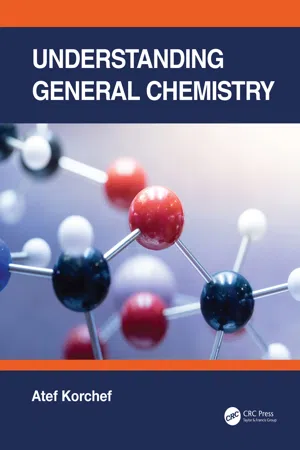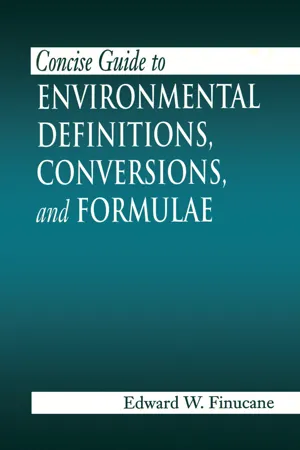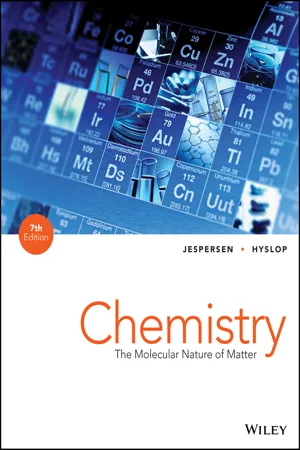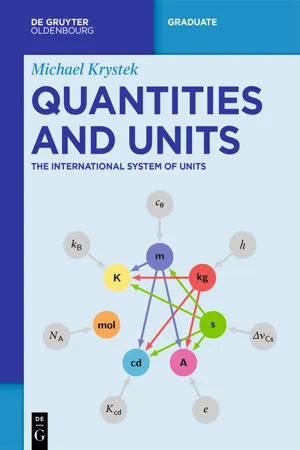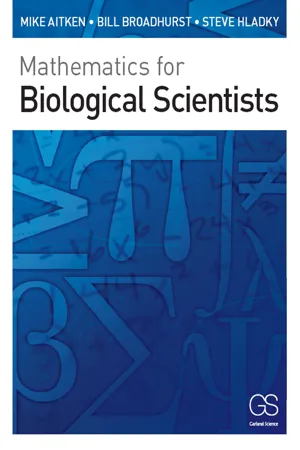Chemistry
SI units chemistry
SI units in chemistry refer to the International System of Units used to measure physical quantities in scientific experiments and calculations. These units provide a standardized way to express measurements, including the meter for length, kilogram for mass, second for time, and others. Using SI units ensures consistency and accuracy in scientific communication and data analysis.
Written by Perlego with AI-assistance
Related key terms
9 Key excerpts on "SI units chemistry"
- No longer available |Learn more
- Steven Boone, Drew H. Wolfe(Authors)
- 2011(Publication Date)
- Collins Reference(Publisher)
CHAPTER 2Chemical Measurements
I n this chapter, we will first discuss the International Standard of Units, the measurement system used by scientists throughout the world. Then, we will consider uncertainty in measurements and significant figures.2.1 INTERNATIONAL SYSTEM OF UNITSScientists have agreed upon a common set of units and standards, even though the U.S. general public uses a different system. Measurements Chemists make both qualitative and quantitative laboratory measurements. Each quantitative measurement expresses the magnitude, the units or label, and the degree of uncertainty. The SI System—A Metric SystemThe Systéme International d’Unités, or the International System of Units (SI), is the measurement system used in chemistry. The International System is a metric system. In the metric system, the conversion of a measurement from one unit to another requires only the shifting of the decimal point.SI Prefixes To scale a SI unit to the proper size for a measurement, the SI system has a series of prefixes that are appended to units. Exercises 2.1 and 2.2 review some of the more important prefixes. Exercise 2.1 What is the meaning of each of the following SI prefixes?(a) micro (μ), (b) mega (M), (c) milli (m), (d) deci (d)Solution 2.1(a) 1 × 10-6 ×, (b) 1 × 106 ×, (c) 0.001 ×, (d) 0.1 ×Exercise 2.2What prefix is used for each of the following: (a) 0.01 ×, (b) 1 × 10-9 ×, (c) 1,000 ×, (d) 1 × 10-12 ×?Solution 2.2 (a) centi, c; (b) nano, n; (c) kilo, k; (d) pico, p Base and Derived SI UnitsAll SI units may be derived from seven base units. They include the following: meter (m), unit of length; kilogram (kg), unit of mass; second (s), unit of time; Kelvin (K), unit of temperature; mole (mol), unit of amount of substance; ampere (A), unit of current; and candela (cd), unit of luminous intensity.All other units in the SI system are derived from combinations of seven base units. These are called derived units. Examples of derived SI units include m2 (area), m3 (volume), kg/m3 (density), and kg m2 /s2 - Albert S. Tarendash(Author)
- 2021(Publication Date)
- Barrons Educational Services(Publisher)
The basis of all science lies in the ability to measure quantities. For example, we can easily measure the length or mass of this book if we have some standardized system of measurement. We use the Système International (SI) and its derivatives because scientists all over the world express measurements in metric units. The SI has established seven fundamental quantities upon which all measurement is based: (1) length, (2) mass, (3) temperature, (4) time, (5) number of particles, (6) electric current, and (7) luminous intensity. For each of these quantities there is a unit of measure based on a standard that can be duplicated easily and does not vary appreciably.Length
The unit of length is the meter (m), which is approximately 39 inches. In chemistry, we also use various subdivisions of the meter: picometer (pm, 10−12 meter), nanometer (nm, 10−9 meter), millimeter (mm, 0.001 meter), centimeter (cm, 0.01 meter), and decimeter (dm, 0.1 meter). The prefixes pico-, nano-, centi-, and so on, are known as metric prefixes. A list of these prefixes appears in Section 1.4.Mass
The unit of mass is the kilogram (kg), which has an approximate weight (on Earth) of 2.2 pounds. (We note that mass and weight are not the same quantity. Mass is the amount of matter an object contains, while weight is the force with which gravity attracts matter.) In chemistry we also use the gram (g; 1000 grams equals 1 kilogram) as a unit of mass.Temperature
Temperature measures the “hotness” of an object. The SI unit of temperature is the kelvin (K). The fixed points on the Kelvin scale of temperature are the zero point (0 K, known as “absolute zero”) and 273.16 K, which is known as the “triple point” of water. (More will be said about the Kelvin scale of temperature in Chapter 6.)In chemistry, we also use the Celsius temperature scale (°C). Originally the fixed points on this scale were set at the normal freezing and boiling points of water (0°C and 100°C, respectively). We can convert between the Celsius and Kelvin scales using the simplified equation that appears in Reference Table T in Appendix 1:Time
The unit of time is the second (s). In chemistry, we also use the familiar minute (min), hour (h), day (d), and year (y) as units of time.- eBook - ePub
- Atef Korchef(Author)
- 2022(Publication Date)
- CRC Press(Publisher)
2 Measurements
DOI: 10.1201/9781003257059-22.1 Objectives
At the end of the present chapter, the student should be able to:- Select the appropriate units in the International System of Units (known by the international abbreviation SI) of measurement.
- Differentiate between fundamental quantity and derived quantity.
- Convert units.
- Define and use the basic methods and tools of measurements, such as significant figures and rounding off.
2.2 Measurements
Measurement is the process of comparing an unknown quantity with another known quantity of the same kind to find out how many times the first includes the second.- Physical quantities are either fundamental (basic) quantities or derived quantities.
- Fundamental quantities cannot be defined in terms of other physical quantities.Examples: length, time, mass, temperature and amount of a substance.
Quantity consists of a number telling us how much, and a unit which shows what the scale of measurement is. Examples of base units in SI are given in Table 2.1 . SI base units of mass, temperature and amount of a substance (kg, K and mol, respectively) are widely used by chemists (Table 2.1 ).TABLE 2.1 Examples of SI base units
Note that:Base quantity SI base unit Name Symbol Name Symbol Length l, x, r, etc meter m Mass m kilogram kg Time t second s Temperature T Kelvin K Amount of a substance n mole mol - The SI unit of mass is kg (with small or lowercase k), not Kg (with capital K).
- The SI unit of the amount of a substance (mole) is denoted by mol (without an “e”), not mole. Also, kg is not the SI base unit for the amount of a substance but the SI unit of mass.
- Edward W. Finucane(Author)
- 2023(Publication Date)
- CRC Press(Publisher)
Chapter 1 The Basic Parameters and Laws of Physics and Chemistry DOI: 10.1201/9781003420002-1The basic parameters or measurements of the physical sciences (including all of the most common and widely used units that apply to each) will be identified and described in this chapter. In addition, the fundamental laws that find significant usage in the overall study and practice of industrial hygiene/occupational safety and health also will be covered in detail.Relevant Definitions
Basic UnitsThere are seven basic or fundamental units of measure in current use today throughout the world. The most widely recognized set of these units, known as the International System of Units (SI), was initially adopted in 1960, and is reviewed and amended, as deemed necessary, at one of the General Conferences on Weights and Measures, an international meeting that convenes periodically. In addition, there are two common “metric” systems, referred to in the text that follows as the MKS System (meters, kilograms, and seconds), and the CGS System (centimeters, grams, and seconds), as well as the “nonmetric” English System (obsolete almost everywhere on Earth, except in the United States). Each of these Systems of Units will be covered.Length
Length is the extent or distance from one end of an object to the other, or a distance in space from one clearly identified point to any other such point.In the International System of Units, the basic unit of length is the meter, which has been defined as the length of path traveled by light in a vacuum during a time interval of 1/299,792,458 of a second.In the MKS System, the basic unit of length is the meter. In the CGS System, the basic unit of length is the centimeter. In the English System, the basic units of length can be either the foot, the inch, or the yard.Mass
In physics, mass is the measure of a body’s resistance to acceleration. The mass- eBook - ePub
Chemistry
With Inorganic Qualitative Analysis
- Therald Moeller(Author)
- 2012(Publication Date)
- Academic Press(Publisher)
1CHEMISTRY: THE SCIENCE OF MATTER
Publisher Summary
This chapter presents some basic definitions of science, matter, and chemistry. It explains the subdivisions of chemistry. The SI system defines a single base unit to measure each of seven quantities such as length, mass, time, electric current, temperature, amount of substance, and luminous intensity. Other necessary units, such as that for volume, are derived from the base units. The chapter reviews the modern units of measurement and a problem-solving method, the factor-dimensional method. With the factor-dimensional method, a unit-conversion calculation, and the calculation needed to solve a problem, can be set up in a single expression. The chapter describes the role of chemistry in coping with the major problems facing mankind.In this chapter we first give some basic definitions—science, matter, chemistry—and then an explanation of the subdivisions of chemistry. We review the modern units of measurement and a problem-solving method—the factor-dimensional method—that will be used throughout this book. In the last section of the chapter we take a brief look at the role of chemistry in coping with the major problems facing mankind.L ook around you. That’s how chemistry began—in the limitless curiosity of human beings about their surroundings .Possibly you are sitting at your desk with some paper and a wooden pencil or a plastic pen at hand to take notes. Maybe there are some metal paper clips and a pottery coffee cup or a glass soft-drink bottle or an aluminum can on your desk. What could you do to investigate the materials in your paper, your pencil or pen, the paper clips, the cup, the bottle, or the can? Scratch them. Which is harder? Put a drop of water, or alcohol, or acid on each one. What happens? Weigh pieces of equal size. Which is heavier? Try to burn a small piece of each. Which ones burn? What is left afterwards? - eBook - ePub
The Reform of the International System of Units (SI)
Philosophical, Historical and Sociological Issues
- Nadine de Courtenay, Olivier Darrigol, Oliver Schlaudt(Authors)
- 2019(Publication Date)
- Routledge(Publisher)
Today, the SI includes the seven base units, the second, metre, kilogram, ampere, kelvin, mole and candela as well as derived units made up of algebraic combinations of the base units, multiples and submultiples and rules for their use. All this is laid out in a document approved by the CIPM and published by the BIPM under the title of The International System of Units SI. It is generally referred to as the SI Brochure. The Brochure, a document of some 75 pages, is now in its 9th edition (2019), and it gives a complete description of the SI. The full text in French and in English is freely available on the BIPM website, and a brief history of the development of ideas during the nineteenth and early twentieth centuries related to units is given in the Introduction. In brief, while there were many advances in definitions of the seven base units of the SI, neither the idea of the great savants of the eighteenth century nor the precepts of Maxwell could be fully realized until now. This was mainly because there had been no way of defining a unit of mass other than as the mass of a particular artefact. Until the redefinition in 2018, the kilogram was still defined as the mass of the International Prototype of the Kilogram kept at the International Bureau of Weights and Measures at Sèvres. However, this problem has now been solved and a fundamental revision of the SI has taken place. The 26th CGPM in 2018 adopted a CIPM proposal to redefine the SI in terms of a set of seven defining constants of nature each having an exact defined numerical value. Taken together they define the same seven base units of the SI that we had before, but they no longer include any material artefacts - eBook - ePub
Chemistry
The Molecular Nature of Matter
- Neil D. Jespersen, Alison Hyslop(Authors)
- 2018(Publication Date)
- Wiley(Publisher)
Chapter 19 . The unit for luminous intensity, the candela, will not be discussed in this book.TABLE 1.2The SI Base UnitsMeasurement Unit Abbreviation Length meter m Mass kilogram kg Time second s Electric current ampere A Temperature kelvin K Amount of substance mole mol Luminous intensity candela cd Base SI UnitsMost of the base units are defined in terms of reproducible physical phenomena. For instance, the meter is defined as exactly the distance light travels in a vacuum in 1/299,792,458 of a second. Only the base unit for mass is defined by an object made by human hands, a carefully preserved platinum–iridium alloy cylinder stored at the International Bureau of Weights and Measures in France (Figure 1.13 ). This cylinder serves indirectly as the calibrating standard for all “weights” used for scales and balances throughout the world.4Figure 1.13 The international standard kilogram. The SI standard for mass is made of a platinum–iridium alloy and is protected under two bell jars, as shown, at the International Bureau of Weights and Measures in France. Precise copies, called secondary standards, are maintained by many countries.In scientific measurements, all physical quantities will have units that are combinations of the seven base SI units. For example, there is no SI base unit for area, but to calculate area we multiply length by width. Therefore, the unit for area is derived by multiplying the unit for length by the unit for width. Length and width are measurements that have the SI base unit of the meter (m) - eBook - ePub
Quantities and Units
The International System of Units
- Michael Krystek(Author)
- 2023(Publication Date)
- De Gruyter Oldenbourg(Publisher)
17 are invariant under such a conversion, there is no need to include quantities such as the angular measures of the plane angle and the solid angle in the category of basic quantities. For mathematical reasons, this is not even possible, since the unit of all quantities of dimension number is the number one. However, as already stated above, the number one cannot be a base unit in any system of units because of its special property.3.2 The international system of units (SI)
The name Système International d’Unités (International System of Units) with the international abbreviation SI was adopted by the Conférence Générale des Poids et Mesures (CGPM) in 1960. The SI has been revised from time to time thereafter to meet user requirements and advances in science and technology. The latest revision of the SI was adopted by the 26th CGPM (2018) and came in force on 20th of May 2019. It is documented in the 9th edition of the SI brochure 18 [2] .The SI is a consistent system of units for all fields of life, including international trade, production, safety, health, environmental protection and the scientific foundations on which all these fields are based. The system of quantities underlying the SI and the associated defining equations are based on the currently accepted description of nature (the so-called laws of nature) and are familiar to all scientists, engineers and technicians.The definition of the SI units of the revised SI of 2019 is done by means of seven so-called defining constants, which are only to some extent natural constants and whose numerical values expressed by the existing SI units are now regarded as invariant.19 These seven constants are the basis of the definition of the base units of the revised SI, because if they are seen as a set of base units, then the base units of the SI can be obtained from them simply by performing a base transformation. The defining constants - eBook - ePub
- Mike Aitken, Bill Broadhurst, Stephen Hladky(Authors)
- 2009(Publication Date)
- Garland Science(Publisher)
Table 1.2 .Table 1.2 Examples of SI derived unitsderived quantityderived unitsymbolarea square meter m2volume cubic meter m3speed, velocity meter per second ms−1acceleration meter per second squared m s−2mass density kilogram per cubic meter kg m−3amount of substance concentration mole per cubic meter mol m−3mass fraction kilogram per kilogram, which may be represented by the number 1 kg kg−1 = 1mole fraction amount of substance per amount of all substances present mol mol−1 = 1per cent per cent % Some of these derived quantities are assigned special names, because it is useful to think of these combinations of units together. For instance, force is sufficiently important that it is measured in its own unit, the newton, with symbol N. However, because 1 N is defined as that force which would accelerate a 1 kg mass at 1 m s−2 ,1 N = 1 kg × 1 ms= 1 kg m− 2s,− 2(EQ1.22) the symbol N is just a synonym for kg m s−2
Index pages curate the most relevant extracts from our library of academic textbooks. They’ve been created using an in-house natural language model (NLM), each adding context and meaning to key research topics.


